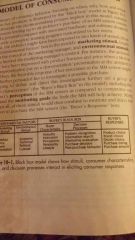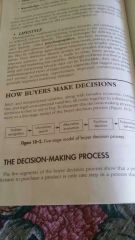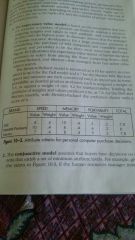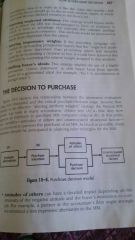![]()
![]()
![]()
Use LEFT and RIGHT arrow keys to navigate between flashcards;
Use UP and DOWN arrow keys to flip the card;
H to show hint;
A reads text to speech;
30 Cards in this Set
- Front
- Back
- 3rd side (hint)
|
consumer behavior |
includes use and disposal of acquisitions includes acquisitions beyond tangible products like services, experiences, and ideas includes behavior of individuals and groups influenced by interpersonal variables (celebrities, co-workers, family members, ect) it's effects resonate from the individual consumer to members of an entire society |
|
|
|
what consumer behavior is |
when, why, where, and how people buy products |
|
|
|
2 kinds of stimuli |
marketing stimuli under marketer's control 4 P's environmental stimuli beyond manager's control |
|
|
|
buyer characteristics |
perception compared other comparative products motivating goals the product helps achieve |
|
|
|
buyers black box |

|
|
|
|
interpersonal & intrapersonal influences |
interpersonal social and cultural groups intrapersonal drives, perceptions, attitudes |
|
|
|
Subculture aspects managers focus on |
1) subcultures that have grown significantly enough to qualify as target markets 2) characteristics of these target markets that marketing programs can be based on |
|
|
|
examples of subcultures that can be target markets |
African American consumers motivated by quality and selection more price conscious and brand loyal Hispanic consumers brand and price conscious tween consumers
baby boomers mature consumers 65+ |
|
|
|
reference group categories |
membership groups the individual already belongs to aspirational groups the individual would like to join disassociate groups whose values in individual rejects |
|
|
|
Force of reference groups depends on... |
cohesiveness of the group more cohesive, more the influence product concept influence concept strongest when product highly visible and seen in use people more influenced by other-directed people as opposed to inner-directed people |
|
|
|
family based groups |
smallest and most important influence in society family of oreientation parents, siblings, imparts behaviors, values toward religion, politics, economics, production of worth, and personal ambition family of procreation spouse and children more direct influence on buyer behavior than any other group |
|
|
|
FLC |
Family life cycle used for relating family influence on buying behavior distinct stages in life of a typical family with different demographic characteristics |
|
|
|
family life cycle stages |
bachelor stage newly married couples full nest 1 full nest 2 full nest 3 empty nest 1 empty nest 2 solitary survivor, in labor force solitary survivor, retired |
|
|
|
demographic intrapersonal variables |
state of being characteristics location age sex race
|
|
|
|
psychographic intrapersonal variables |
motivation marketing can stimulate a motivationor can satisfy a motivation perception how people derive meaning from the selection, organization, and interpretation of stimuli
attitude
lifestyle |
|
|
|
3 perception related concepts |
selective exposure people can only process small percentage of stimuli
selective distortion people change meaning of dissonant stimuli to be consistent with beliefs and feelings
selective retention people remember stimuli that support feelings and beliefs and forget those that don't
|
|
|
|
4 product related attitudes |
utilitarian ability to help achieve desired goals ego-defensive defend buyer's self image value expressive consistency of product with buyer's central values or self image knowledge ability of product to give meaning to beliefs and experiences |
|
|
|
psychographics |
measuring: attitudes interests opinions ^ for diverse areas politics economics recreation, ect |
|
|
|
buyer decision process |

|
|
|
|
effects of buying situations on decision making |
1) amount of involvement and complexity involved 2) number of individuals who influence the decision |
|
|
|
buyer decision categories |
routinized problem solving low cost low risk low involvement
, service, and availability2) attract new customers product development Limited problem solving when buyer encounters new brands in familiar product classes marketers should1) designing communication programs to increase buyer confidence extensive problem solvingproduct class is newhigh involvement, visible, and expensive productsMany risks involved1) performance risk2) financial risk3) psychological risk4) sock all risk5) time-lapse risk
extensive problem solvingproduct class is newhigh involvement, visible, and expensive productsMany risks involved1) performance risk2) financial risk3) psychological risk4) sock all risk5) time-lapse risk extensive problem solvingproduct class is newhigh involvement, visible, and expensive productsMany risks involved1) performance risk2) financial risk3) psychological risk4) sock all risk5) time-lapse risk extensive problem solvingproduct class is newhigh involvement, visible, and expensive productsMany risks involved1) performance risk2) financial risk3) psychological risk4) sock all risk5) time-lapse risk extensive problem solvingproduct class is newhigh involvement, visible, and expensive productsMany risks involved1) performance risk2) financial risk3) psychological risk4) sock all risk5) time-lapse risk extensive problem solvingproduct class is newhigh involvement, visible, and expensive productsMany risks involved1) performance risk2) financial risk3) psychological risk4) sock all risk5) time-lapse risk extensive problem solvingproduct class is newhigh involvement, visible, and expensive productsMany risks involved1) performance risk2) financial risk3) psychological risk4) sock all risk5) time-lapse risk |
|
|
|
information search |
1) some search customer is receptive to product information 2) active information search actively searching for information |
|
|
|
information sources |
commercial information sources personal information endorsements |
|
|
|
expectancy model |
assumes buyers consider a number of attributes in making decisions |

|
|
|
conjunctive model |
assumes buyers base decisions on criteria that satisfy a set of minimum attribute levels |
|
|
|
disjunctive model |
assumes an either/or decision based on high attribute levels. |
|
|
|
lexicongraphic model |
assumes people make descisions based on most salient attributes (the ones first thought of) in case of tie, buyer goes to next set of attributes |
|
|
|
strategies to make a product the choice set |
real repositioning psychological positioning alter perceptions to make buyers recognize facts competitive depositioning making rival products less accurate highlighting incorrect perceptions stressing neglected attributes
altering importance weights increasing weight buyers assign to attributes shifting buyer's ideals use of a "cosmic statement" to shift buyer focus from specific issues to generalized ideas |
|
|
|
purchase decision model |

|
|
|
|
post purchase behavior |
psychological response cognitive dissonance according to Leon Festinger, all buyers have some dissonance after purchasing post-purchase reaction satisfied customers more likely to repurchase |
|

